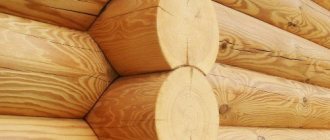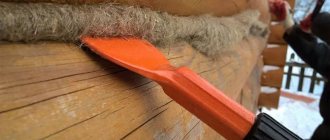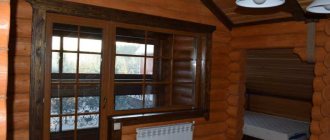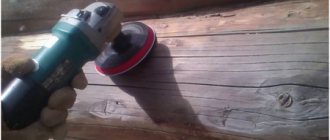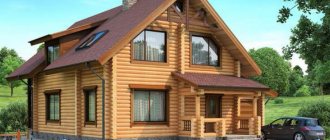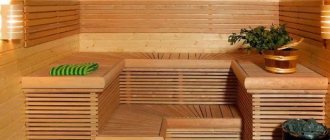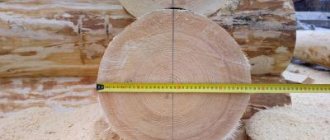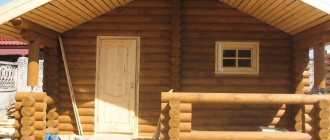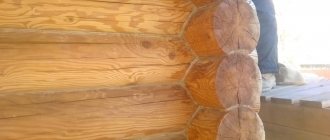Wood is one of the first building materials used by man to build a house. People are attracted to it, first of all, by its naturalness, good heat-saving properties, and unique beauty. We associate a typical rustic log house with an atmosphere of comfort and characteristic warmth.
Nowadays, buildings made from logs processed on rounding machines are very popular. But any master will tell you that wood is a very capricious material. It is afraid of water, but at the same time its pores should not be sealed and “breathing” should not be prevented.
Wood is susceptible to fungus, mold, woodworms, it belongs to the group of highly flammable materials, sometimes the logs of an already built log house can “twist”, they bend and crack. We will tell you how to deal with these problems in this article.
Where to begin
It is advisable to begin caring for wooden structures immediately after assembling the house. Fungi and insects can extremely quickly spoil even high-quality wood, so the task is to prevent them from settling in the wood.
If construction is carried out in spring, autumn or summer, the log must be treated with antiseptics. In winter, this procedure is postponed until the weather warms up.
It is especially important to keep an eye on the ends. Open cuts are channels for the penetration of fungal and mold spores. For processing, it is recommended to use special impregnations or lime.
Difficulties in self-processing
Many owners of wooden houses think that preserving the external walls of a log house is an easy and simple job. Indeed, if you look at it, there is no difficulty in treating with an antiseptic, but only if the work is undertaken by knowledgeable and trained specialists who have repeatedly carried out the treatment and know all its intricacies.
If non-professionals try to do the treatment, then, as a rule, they find it difficult to choose a drug and do not know how to apply the product correctly. But the correct choice of antiseptic and compliance with the technology for its application are the most important conditions for high-quality and durable treatment.
Home craftsmen also make other unforgivable mistakes:
- due attention is not paid to surface preparation;
- one layer of antiseptic is applied, which guarantees short-term protection of the wood;
- processing is carried out at low temperatures.
All this affects the quality of processing and requires repeated work.
Antiseptic treatment of a wooden house is one of the main services provided. Our specialists carefully and thoroughly approach the selection of preparations for processing logs, taking into account all the features of a particular object. We guarantee fast and high-quality processing, which will protect your home from any adverse influences for many years.
You can leave your request or contact us using the coordinates on the “Contacts” page in a way convenient for you.
Calculate the cost of painting and insulating your home right now
Select types of work:
Select materials:
What kind of finishing is needed
After the frame shrinks, which lasts from 6 to 12 months, you can begin to finish painting the walls outside. First, sanding is carried out to remove the top layer of wood that has turned gray in the sun, then paint is applied in several layers.
The finish needs to be renewed every 5-15 years, depending on the paint manufacturer's recommendations. It is desirable that the compositions have vapor-permeable properties and allow the wood to “breathe,” because this is what houses made from rounded logs are valued for.
There is no need to paint the walls inside. You can leave the tree in its natural state, preserving its natural qualities. If desired, the logs are sheathed with any decorative and finishing material.
High humidity is a dangerous factor that provokes the formation of mold and mildew. It is not only the external attractiveness of the wooden frame that suffers. Pockets of moisture instantly initiate rotting processes and significantly reduce the life of the house. If you find leaks, fix them as quickly as possible.
Do logs need additional protection?
When choosing a log for a log house, you need to think about its durability in advance.
The fact is that different processing methods greatly affect the wood’s resistance to rotting:
- Rounded logs, compared to other types of round timber, are especially susceptible to moisture; their natural protection is practically negated during processing. The fact is that during calibration, not only the bark, but also a thick layer of dense wood is removed from the trunk;
Rounded round timber has minimal natural protection from moisture and insects
Note! Sometimes, during processing, the core of the trunk even comes out on the side surface. In this case, the log has practically no natural protection, so impregnation is simply necessary, and as deep as possible.
- But debarked logs lose only their bark; a protective layer of very hard wood remains. Impregnation is also needed here, but the durability of a log house made of such material will be higher. The only thing that may confuse you is the high price of debarked round timber compared to round timber;
Barked log is the best option for a log house
- Planed logs occupy an intermediate position between debarked and rounded logs.
Impregnating wood with antiseptics not only provides protection from rot and insects, but also reveals the texture of the wood. So you can apply a layer of clear varnish on top, and the wooden surface will already look good.
You can come across recommendations not to use impregnation at all for a log house, they say the round timber will be preserved perfectly as it is. But it’s better to treat the wood, at least to preserve its appearance, and the protection will be more reliable.
If the log is not treated, it will darken over time.
About shrinkage
After assembling a wooden house for 6-12 months, excess moisture from the logs evaporates, their volume decreases by 5-11%. All work is suspended for this period.
Deformations are uneven - moisture evaporates most quickly from the outer layers of wood, then from the inner ones. The geometry of the openings changes, so it is not recommended to install doors and windows in the first year after assembly. To prevent damage, the rafter system is secured temporarily or using sliding supports.
Shrinkage of structures will continue for several more years, but at a much slower rate. To prevent damage to windows and doors, casing and frames are fixed in the openings. Their design includes elastic gaskets to compensate for movements.
The resulting cracks are a path for cold penetration and an open gate for fungal spores. After shrinking, they need to be filled with natural or synthetic sealants, acrylic sealant.
Summarizing
Processing round timber is a good way to increase its durability, and its appearance will remain for a long time. In this case, it is necessary to take into account a number of nuances, namely: selecting separate compositions for interior and exterior decoration, properly treating the ends of the logs and sealing cracks. Subject to these conditions, treatment with an antiseptic becomes absolutely harmless to humans and prolongs the life of the log house.
The video in this article describes the external processing of a log house.
Communications in a house made of rounded logs
Wood is a flammable material, so increased safety requirements are imposed on communications, especially electrical ones.
Power cables are laid in the following ways:
- hidden;
- external
Hidden wiring is much more difficult to do. Metal corrugated tubes are used to prevent the fire of wooden structures in the event of a short circuit. They are laid in floors, interfloor ceilings, false walls or frame partitions. Small areas remain visible, which can be decorated in accordance with the design of the premises.
The water supply and sewage systems are isolated as much as possible from the walls of the house, and the pipe joints are carried out to the boiler room and to water collection points.
Open wiring is much easier to install. Non-flammable cable ducts and fittings are used for fastening to log walls. They are produced in different colors, including wood. After installation they remain invisible and do not spoil the interior.
When installing boilers, furnaces and other fire-hazardous equipment, it is important to prevent overheating of wood and sparks from open fire.
Installation of protective devices is mandatory.
How to treat logs
The choice of special compounds for treating wooden surfaces is very wide. For the most part, all popular antiseptics provide good protection against moisture and insects, the only thing is that you need to not confuse the means for external treatment and internal treatment. Indoors, compounds are usually used that do not release substances harmful to humans.
Internal processing of log houses
Treatment of logs on the inside is also necessary, although operating conditions will be more gentle than on the outside, but the humidity level can vary over a wide range, and you should not forget about insects.
As for the types of products used, the following types of solutions can be distinguished:
- easily washed out - as an example, saline solution can be used. This is too much of a budget option; it can only be recommended for processing auxiliary buildings and then as a temporary measure;
The saline solution can be used to treat surfaces that will not be exposed to rain.
- penetrating - treating rounded logs with this composition guarantees the penetration of the antiseptic to a decent depth (depending on the type of wood, but in most cases it will reach a depth of 5-7 mm). They do not wash out over time, and also allow the wood to breathe;
- film-forming - used rather to decorate the surface of the wood; the liquid does not penetrate deep into the wood. Such compositions are applied after impregnation with an antiseptic to give the desired shade to the wood.
To treat wooden surfaces inside the house, you can use, for example, SenezhAquadecor. It does not stain the surface of the wood, is absorbed deeply enough and does not create an impenetrable layer on the surface after drying, so the logs are not in danger of rotting from the inside.
One of the good options for interior work
Processing of a log house after installation of logs includes impregnation of rafter frames, as well as elements of wooden floors. Since they will not be visible, it is advisable to use compositions with coloring properties. This is done so that the treated and untreated areas can be clearly distinguished.
Antiseptics can paint wood a green tint, but the tint of the surface treated with a fire retardant is reddish. Of course, such compositions are not suitable for treating floors or ceilings.
The base of the rafter system is treated with an antiseptic with a green tint
External processing
Treating a log house with protective compounds on the outside gives much greater scope for creativity. At the same time, antiseptics can be used both as a prophylactic agent and for the preservation of existing defects.
Note! Treatment with a potent compound will freeze the development of rot in the wood, but there is a limit to everything. If the log is severely damaged, then no amount of impregnation will help.
When processing externally, you will have to solve several problems:
- carefully caulk the cracks and cracks in the logs;
- the ends of the logs are also processed (a separate compound is used);
- Only after this can you proceed to sanding the wall and applying antiseptic.
Wide and deep cracks in logs are far from uncommon; because of them, moisture and insects can easily reach the especially vulnerable central part of the log.
Fortunately, sealing cracks can be done with your own hands; for this you will need:
- clean the crack from dust and dirt;
- push the sealing material inside (there are special cords made of synthetic materials on sale). You can also use ordinary natural fabric;
The correct sequence of actions when filling joints and cracks with sealant
- then fill the rest of the crack with sealant; it is quite elastic, so when the house settles it will still provide a reliable connection between the edges.
Carefully filled joints and cracks look great
The question of how to treat the ends of logs is especially important because it is through the ends that the logs lose moisture at an accelerated rate. This is what causes cracks to occur. In addition, through the ends it is easier for moisture and insects to penetrate inside.
The photo shows an example of a careless attitude towards protecting logs
Note! To treat the end of the log, special compounds are used that slow down the evaporation of moisture.
Usually the problem of how to process log sections is solved at the stage of harvesting round timber, but it is better to play it safe and process them yourself again.
To do this, you can use both folk and purchased remedies:
- The simplest recipe is to apply paraffin; this “chemical dead man” is guaranteed not to let moisture in;
Paraffin will preserve the original appearance of the end of the log
- You can also use purchased compounds, the same “Senezh TOR” does not contain substances harmful to humans, and treating log logs with an antiseptic at the ends normalizes the shrinkage of the log in the transverse and longitudinal direction.
Does chopped sauna require processing?
If there are no particular problems with the question of how to treat the outside of a log house, then in the case of a wooden bathhouse you have to take into account the specifics of its operation. Experts are still inclined to believe that impregnation with an antiseptic from the inside is not necessary.
In this case, it is advisable to use debarked or planed logs with sufficiently high natural protection (meaning the content of resinous substances) as a building material. You just need to take into account that the use of tree species with a high resin content is unacceptable; due to the high temperature, the walls will be constantly sticky.
Recommendations for the use of different tree species
In principle, the instructions allow the processing of a chopped bath from the inside, but with a number of reservations:
- it is forbidden to use compounds that, when exposed to high temperatures, release harmful substances (that is, the lion's share of antiseptics is immediately eliminated);
- The wood must remain breathable.
If the problem of how to process the logs inside the bathhouse is perplexing, then you can try to limit yourself to external processing only. If the inside of the wood darkens a little after some time, you can simply sand the logs with a flap wheel; a pleasant shade of natural wood is guaranteed for several years.
Main grinding tool
Note! Various folk remedies, for example, based on beeswax, oil, resin, etc., are not suitable for internal bath treatment precisely because of their low resistance to high temperatures.
If the bathhouse is built from inexpensive calibrated round timber, then external treatment is required. Considering that harmful substances have an unpleasant tendency to seep through wood and enter the air (especially at high temperatures), the product must be 100% harmless.
In principle, you can purchase logs already impregnated with a protective composition, but the question of how best to treat a rounded log in a bathhouse is still better to decide for yourself. The fact is that during factory impregnation, they don’t really think about the environmental friendliness of the antiseptic.
How to protect a wooden house from pests
The most destructive effects on wood are:
- Fungal infections . They appear in the form of spots of various colors, blue, black, mold, dry or wet rot. Antiseptic treatment of wood immediately after cutting and during use helps prevent them. To eliminate signs of the disease that have already appeared, it is recommended to treat the area with special agents that return the color to the wood.
- Insects . Complex antiseptic impregnations allow you to avoid infection by bark beetles, shawls or borers. Treatments should be repeated at least once every 5 years. If larvae or bugs do appear, you can get rid of them by injecting disinfectant solutions, fumigating with chemicals, and repeated treatments with fumigators.
- Rodents . Laying out poisoned baits, using repellents, and keeping a cat in the house helps in the fight. It is important to block the entry routes for pests into your home. To do this, at the construction stage, the lower joints are covered with a fine-mesh mesh, and the cracks are carefully sealed.
Regular maintenance will help keep your home safe and comfortable. The sooner you start activities, the longer wooden structures will last.
SEQUENCE OF APPLYING PROTECTIVE COMPOUNDS ON A LOG
It is very important to use all wood protection products comprehensively, this means that the use of all products has completely equal priorities:
- At the harvesting stage, you will need to treat the wood with antiseptic solutions. They will prevent the development of rotting, and will also prevent pests from destroying the wood.
- Next, the wood is treated with fire retardants; they will prevent fire and protect the wood from ignition for several hours. The choice of fire retardant depends entirely on the customer’s preferences; fire safety standards are also taken into account. Before purchasing a fire retardant, you must pay attention to its compatibility with other wood preservatives.
- After this, the wood is treated with water-repellent impregnations, which will prevent excess moisture from entering the wood structure. In this case, excess moisture from the wood will be completely freely removed to the outside, so drying of the wood will take place in an absolutely normal manner. Protecting wood with water-repellent impregnations will prevent the leaching of fire retardants and antiseptics.
- A varnish containing protective substances against ultraviolet radiation is suitable as the last layer.
Requirements for internal processing facilities
When choosing a composition for internal processing of imitation timber, eurolining, profiled timber or logs, criteria such as environmental friendliness and safety come to the fore. When choosing a drug, you need to carefully study its label. It should say on it that the product can be used for interior work. Many manufacturers indicate on the packaging detailed information about all the components included in the product.
What is the best way to protect the walls inside the house? For interior spaces, it is advisable to use water-based products. Such preparations usually have a neutral odor, do not contain toxic substances, and are safe for humans.
Why is it necessary to process the ends of logs?
Log cuts need additional protection, because first they crack, darken and change their natural shade to gray.
The reason for this is that the protruding end exposes the softest inner part of the tree.
Even in order to leave the log house in its natural state, the ends will still have to be treated with preparations. This is due to several reasons:
- Increased dampness. Open cuts are vulnerable to external factors. Longitudinal fibers absorb water more actively than transverse fibers, which is why this part of the log quickly becomes damp.
- The appearance of fungus. A large amount of moisture is the cause of mold. It softens the cut line, which is why the open ends rot and then crack.
- Uneven evaporation. Through saw cuts, moisture evaporates faster, this causes deep cracks and deformation of the crowns of the log house.
- The appearance of insects. Rapid evaporation of moisture contributes to the appearance of looseness. Because of this, the interior of the tree becomes vulnerable to temperature changes, and is also easily attacked by woodworms and other insect larvae that destroy it.
Treated ends slow down the evaporation of moisture and make this process more uniform. During shrinkage and shrinkage, the logs crack less, preserving the heat-insulating properties of the structure and its appearance.
